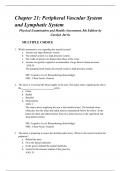-
1. Tentamen (uitwerkingen) - Chapter 01: evidence-based assessment [physical examination and health assessment, 8t...
-
2. Tentamen (uitwerkingen) - Chapter 02: cultural assessment {physical examination and health assessment, 8th edit...
-
3. Tentamen (uitwerkingen) - Chapter 03: the interview {physical examination and health assessment, 8th edition by...
-
4. Tentamen (uitwerkingen) - Chapter 04: the complete health history physical examination and health assessment, 8...
-
5. Tentamen (uitwerkingen) - Chapter 05: mental status assessment physical examination and health assessment, 8th ...
-
6. Tentamen (uitwerkingen) - Chapter 09: general survey and measurement physical examination and health assessment...
-
7. Tentamen (uitwerkingen) - Chapter 06: substance use assessment physical examination and health assessment, 8th ...
-
8. Tentamen (uitwerkingen) - Chapter 07: domestic and family violence assessment physical examination and health a...
-
9. Tentamen (uitwerkingen) - Chapter 08: assessment techniques and safety in the clinical setting physical examina...
-
10. Tentamen (uitwerkingen) - Chapter 13: skin, hair, and nails physical examination and health assessment, 8th ed...
-
11. Tentamen (uitwerkingen) - Chapter 10: vital signs physical examination and health assessment, 8th edition by ca...
-
12. Tentamen (uitwerkingen) - Chapter 11: pain assessment physical examination and health assessment, 8th edition b...
-
13. Tentamen (uitwerkingen) - Chapter 12: nutrition assessment physical examination and health assessment, 8th edi...
-
14. Tentamen (uitwerkingen) - Chapter 16: ears physical examination and health assessment, 8th edition by carolyn j...
-
15. Tentamen (uitwerkingen) - Chapter 14: head, face, neck, and regional lymphatics physical examination and health...
-
16. Tentamen (uitwerkingen) - Chapter 15: eyes physical examination and health assessment, 8th edition by carolyn j...
-
17. Tentamen (uitwerkingen) - Chapter 19: thorax and lungs physical examination and health assessment, 8th edition...
-
18. Tentamen (uitwerkingen) - Chapter 17: nose, mouth, and throat physical examination and health assessment, 8th e...
-
19. Tentamen (uitwerkingen) - Chapter 18: breasts, axillae, and regional lymphatics physical examination and health...
-
20. Tentamen (uitwerkingen) - Chapter 20: heart and neck vessels physical examination and health assessment, 8th e...
-
21. Tentamen (uitwerkingen) - Chapter 23: musculoskeletal system physical examination and health assessment, 8th ed...
-
22. Tentamen (uitwerkingen) - Chapter 21: peripheral vascular system and lymphatic system physical examination and...
-
23. Tentamen (uitwerkingen) - Chapter 22: abdomen physical examination and health assessment, 8th edition by carol...
-
24. Tentamen (uitwerkingen) - Chapter 26: anus, rectum, and prostate physical examination and health assessment, 8t...
-
25. Tentamen (uitwerkingen) - Chapter 24: neurologic system physical examination and health assessment, 8th edition...
-
26. Tentamen (uitwerkingen) - Chapter 25: male genitourinary system physical examination and health assessment, 8t...
-
27. Tentamen (uitwerkingen) - Chapter 29: the complete physical assessment: infant, child, and adolescent physical...
-
28. Tentamen (uitwerkingen) - Chapter 27: female genitourinary system physical examination and health assessment, ...
-
29. Tentamen (uitwerkingen) - Chapter 28: the complete health assessment: adult physical examination and health as...
-
30. Tentamen (uitwerkingen) - Chapter 32: functional assessment of the older adult physical examination and health...
-
31. Tentamen (uitwerkingen) - Chapter 30: bedside assessment and electronic documentation physical examination and...
-
32. Tentamen (uitwerkingen) - Chapter 31: the pregnant woman physical examination and health assessment, 8th editi...
-
Meer zien





